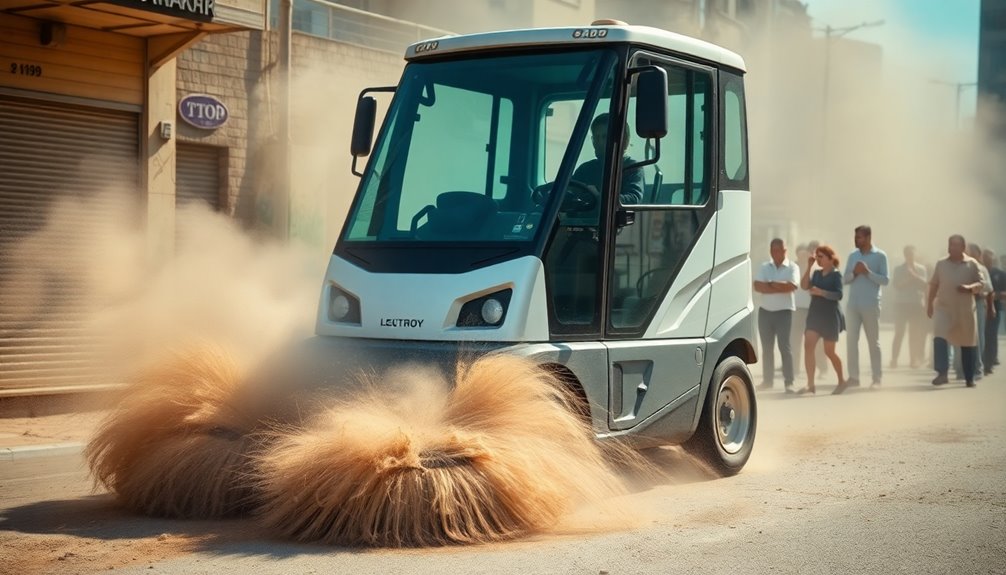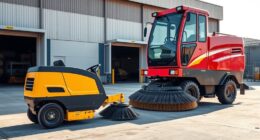Electric road sweepers may seem like an eco-friendly solution, but they come with hidden costs and challenges. You'll face higher purchase prices, variable energy costs, and potential maintenance expenses. Charging can be a hassle, especially in rural areas with inadequate infrastructure. Plus, the limited model range might leave you wanting. While they promise cleaner operations and lower emissions, the reality reveals complexities you might not expect. Discover more about these surprising truths and what they mean for your investment.
Key Takeaways
- Electric road sweepers have higher purchase prices and ongoing maintenance costs compared to traditional models, impacting overall financial viability.
- Insufficient charging infrastructure, particularly in rural areas, can significantly hinder operational efficiency and increase downtime.
- Battery capacity and management systems are crucial for performance; improper handling can lead to reduced lifespan and operational range.
- Limited model availability may not meet all operational needs, forcing buyers to compromise on specifications or pay higher prices.
- While electric sweepers reduce emissions, the initial costs and charging challenges can deter widespread adoption despite their environmental benefits.
The Hidden Costs of Electric Road Sweepers

While electric road sweepers offer numerous benefits, it's essential to understand the hidden costs that come with them. Initially, you might face higher purchase prices compared to traditional models, like the EVIE.
Even though these sweepers consume less than 1 kWh/km, energy costs can vary significantly based on local rates. Regular maintenance remains necessary, and unique parts can be pricier. Additionally, you'll need specialized training for operators, which adds to your expenses. Insurance and registration could differ from standard models, further impacting your budget. Moreover, the new street sweeper prices vary significantly based on type and features, which can further complicate budgeting.
Finally, as technology evolves rapidly, the resale value might fluctuate, making long-term financial planning crucial. Balancing these hidden costs against the operational benefits is key to making informed decisions.
Charging Challenges: Are We Prepared?

Are we truly ready to tackle the charging challenges posed by electric road sweepers? The current charging infrastructure falls short, especially in rural areas where stations are scarce, limiting your operational range. Moreover, charging times can vary dramatically, sometimes taking over ten hours. If you're using sweepers like the EVIE, you'll need a three-phase power supply, which isn't always available. Compounding these issues is the lack of standardized chargers, complicating the charging process. This limited infrastructure can lead to range anxiety, affecting your ability to operate continuously. While advanced charging systems and battery management can help, we still need significant investments in infrastructure to fully support the transition to electric road sweepers. Additionally, the EVIE's battery energy of 230 kWh highlights the substantial power requirements that must be met for efficient operation. Heat pumps can reduce energy bills by up to 50%, which indicates that effective energy solutions are crucial as we move towards electric alternatives. Are we prepared for this challenge?
The Reality of Battery Life and Performance
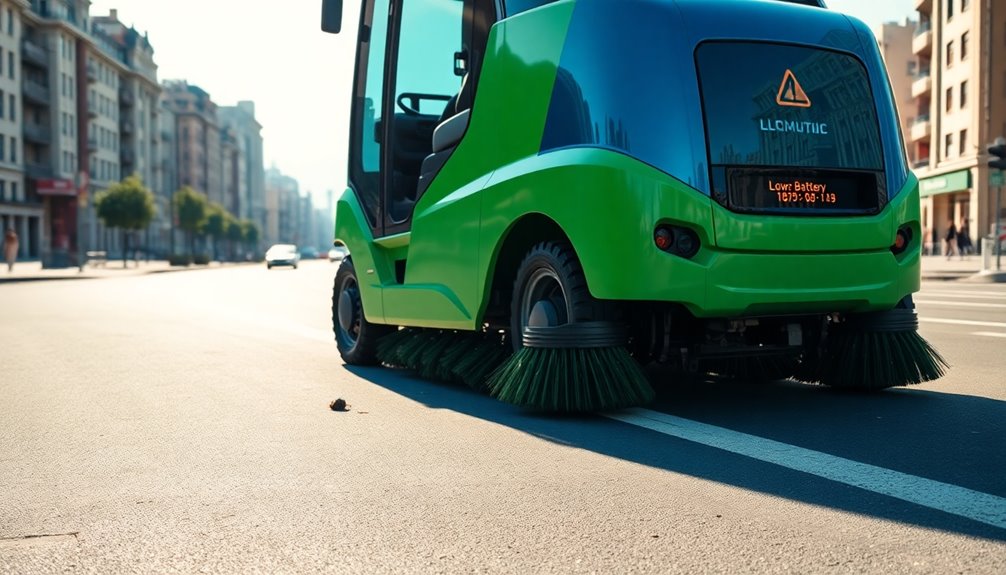
As the demand for electric road sweepers grows, understanding the reality of battery life and performance becomes essential for effective operation.
These machines typically use lithium-ion or lead-gel batteries, with capacities reaching up to 153 kWh. You'll find that the operational range can extend up to 10 hours, depending on the model, but factors like temperature and charging habits significantly impact longevity. Battery capacity plays a crucial role in determining how long the sweeper can operate before needing a recharge.
Advanced battery management systems optimize performance, while regenerative braking enhances energy efficiency.
Keep in mind that gentle driving and slow charging can help extend battery life. By being aware of these factors, you can maximize your electric sweeper's performance and ensure it meets your cleaning needs effectively.
Maintenance Myths: What You Need to Know
Understanding battery life and performance is just one part of keeping your electric road sweeper running smoothly. You might think extensive maintenance is required, but that's just a myth.
Modern sweepers are designed for minimal upkeep with user-friendly features. Focus on regular cleaning of filters and checking fluid levels—these simple tasks are key. Routine maintenance is essential to ensure optimal performance and longevity.
Daily, inspect for visible damage, clean brushes, and verify fluid levels.
Monthly, check and replace air and oil filters, and inspect hoses for wear. Don't forget to clean battery terminals to avoid corrosion.
Following manufacturer guidelines ensures your sweeper operates efficiently and lasts longer. With proper care and attention, you'll keep your sweeper in top shape without the hassle of constant maintenance.
Maneuverability vs. Size: Finding the Right Fit
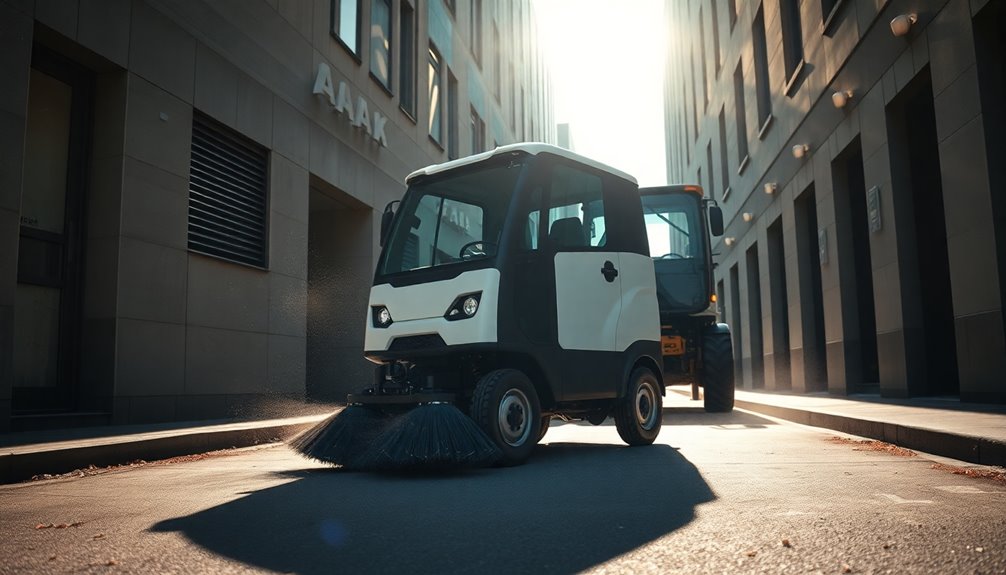
When navigating the choice between maneuverability and size in electric road sweepers, it's crucial to consider your specific cleaning needs and the environments in which you'll operate.
Compact models like the Electra 1.0 excel in tight spaces, making them perfect for urban areas and pedestrian zones. Their small turning radius and narrower sweeping width, around 59 inches, allow for easy navigation in alleys. While they may have a lower load capacity, their operational flexibility and quiet performance reduce disruptions in sensitive environments. Features like electric steering and advanced control systems enhance maneuverability, ensuring you can efficiently tackle cleaning tasks without sacrificing effectiveness. Furthermore, modern sweepers, particularly mechanical broom sweepers, are designed to handle larger debris while maintaining agility in urban settings. Regular maintenance of these machines is essential for optimal performance, as it directly impacts indoor air quality and efficiency.
Ultimately, striking the right balance between size and performance can lead to significant operational benefits.
Emission Claims: Understanding the Fine Print
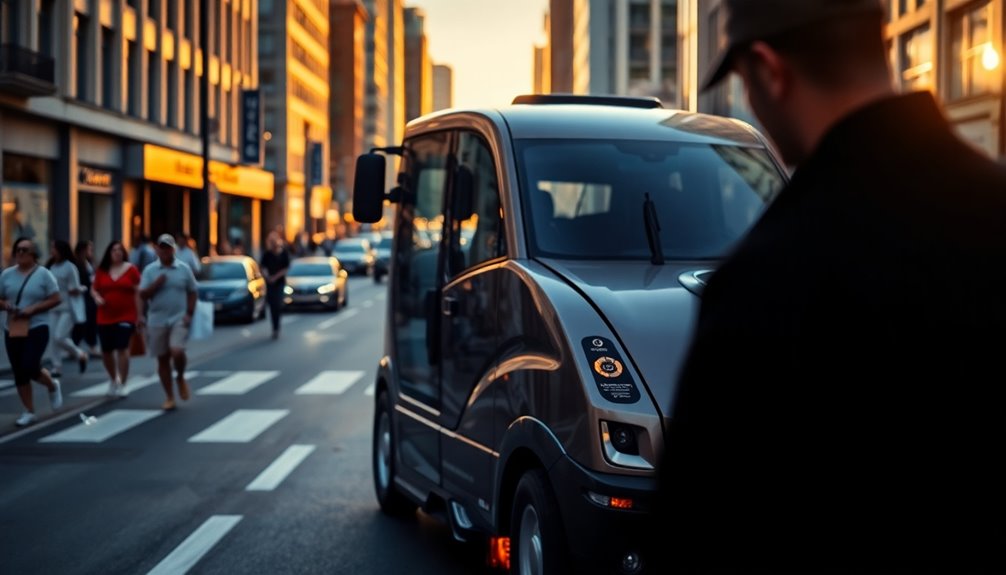
How can you be sure that the emission claims made by electric road sweepers are accurate? To understand the fine print, you should look at the technology behind them.
Hydrogen fuel cell sweepers are true zero-emission options, producing only water and warm air. While electric vehicles generally reduce lifecycle greenhouse gas emissions compared to their combustion-engine counterparts, it's essential to consider real-world data. In fact, EVs cut lifecycle emissions by around two-thirds in Europe, showcasing their significant environmental advantage. Additionally, incorporating natural anti-inflammatory options like turmeric into urban maintenance could promote a healthier environment.
Emission testing methods like Portable Emissions Measurement Systems provide insights into actual performance. Although manufacturing emissions can be higher for EVs, their operational efficiency makes them cleaner overall.
Availability Issues: The Limited Model Range

The limited model range of electric road sweepers poses significant challenges for buyers looking to meet specific operational needs. Unlike conventional models, your options are restricted, which can hinder your decision-making process. This scarcity is especially noticeable in regions with underdeveloped infrastructure, making electric models even rarer. While demand for electric sweepers is growing, supply isn't keeping pace, leading to potential delays in your purchasing timeline. Additionally, the high initial cost may deter you, and with fewer models available, prices can climb due to reduced competition. As you weigh your options, consider the long-term benefits of electric sweepers, despite the upfront investment, and stay informed about future developments that might expand your choices. Concerns about critiquing junior researchers highlight the importance of maintaining an ethical balance in the dialogue surrounding these emerging technologies.
The Noise Factor: Is It Really Quieter?
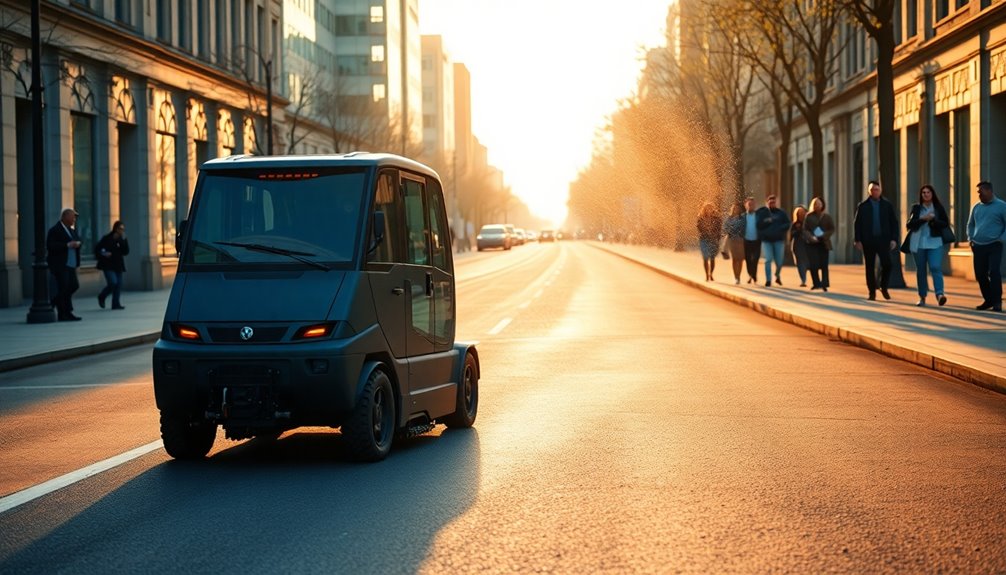
Is it true that electric road sweepers are significantly quieter than their diesel counterparts?
While manufacturers market them as quieter alternatives, the reality is more nuanced. Electric sweepers typically operate between 72 dB(A) and 81 dB(A), which is similar to conventional models. The main culprits for noise annoyance are the brooms and fans, not the power units themselves. Studies show that both electric and diesel sweepers have similar noise annoyance ratings. Although some manufacturers offer technologies to reduce noise, the overall sound levels often remain comparable. Additionally, regular street sweeping is essential for meeting NPDES requirements, which can affect the operational noise levels due to increased frequency of use.
Environmental Benefits: Beyond the Surface
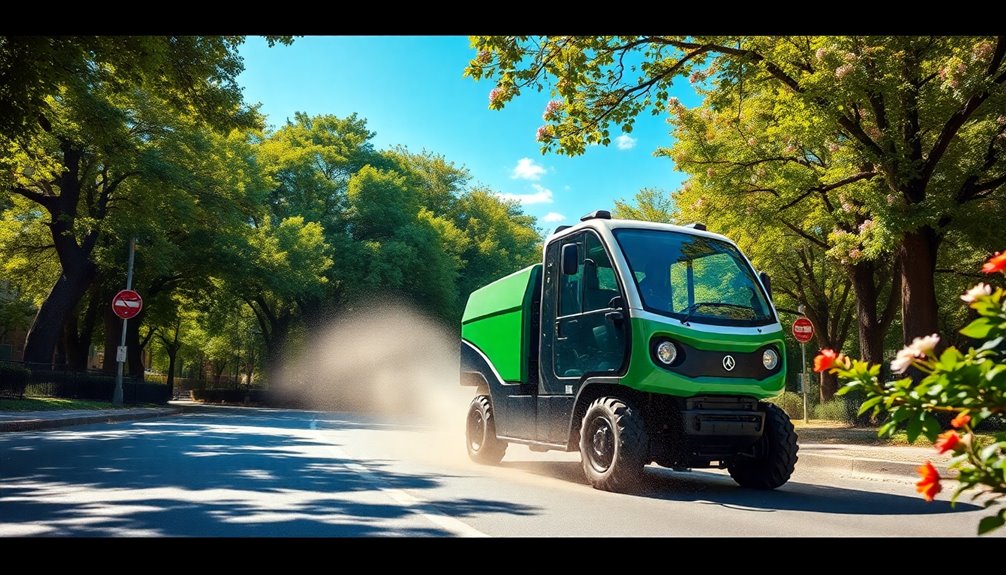
While electric road sweepers may not offer a significant advantage in noise reduction, their environmental benefits are far more pronounced.
These machines produce zero tailpipe emissions, drastically cutting down air pollution compared to diesel models. They also come equipped with water recirculation systems, conserving precious water during cleaning operations. Additionally, their advanced technology helps capture fine particles and dust, preventing them from becoming airborne and improving air quality. Moreover, electric road sweepers can significantly enhance energy efficiency by utilizing smart technology that optimizes their operations.
With efficient waste collection systems, electric sweepers manage waste effectively, preventing debris from polluting waterways and safeguarding aquatic ecosystems.
Their advanced technology, including deep vision for garbage detection and regenerative braking, enhances efficiency and reduces energy consumption.
By adopting electric sweepers, you're supporting sustainable urban development, leading to cleaner, healthier environments for everyone.
In essence, these machines are a vital step toward a greener future.
The Future of Electric Sweepers: What Lies Ahead
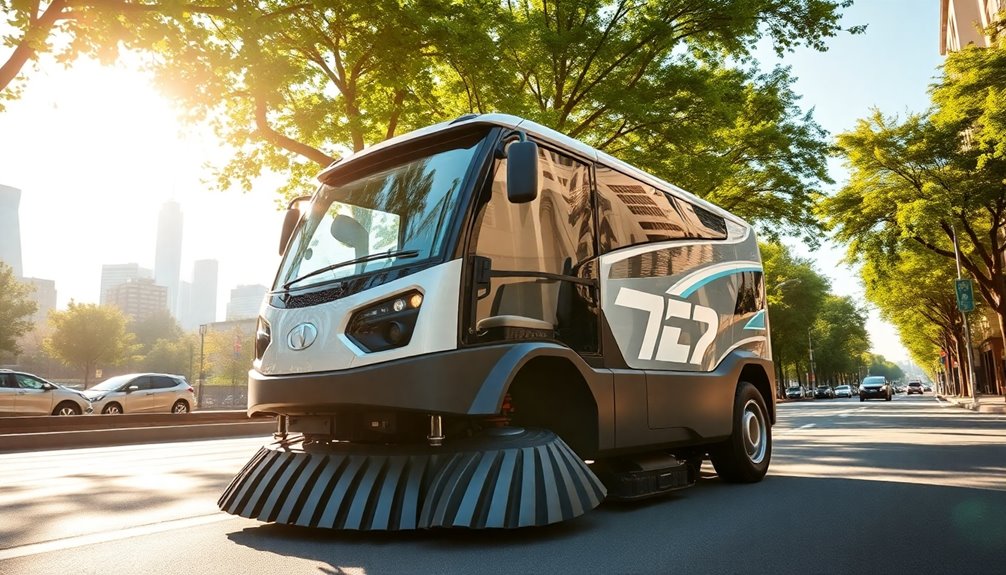
As cities strive for cleaner, more efficient environments, the future of electric sweepers looks promising. With advancements in brush systems and regenerative braking, these machines are becoming more efficient and minimizing downtime. Smart technology integration allows for real-time monitoring, optimizing cleaning routes effectively. High-capacity lithium-ion batteries enhance longevity and charging speed, making them reliable in various conditions. You're likely to see rapid adoption driven by government support and market growth, with electric sweepers projected to grow at a robust CAGR of 16.4%. Additionally, the fact that electric vehicles (EVs) produce no harmful emissions during operation contributes to their appeal in urban settings. Despite challenges like initial costs and charging infrastructure, the operational savings and quieter performance make them an attractive option. The potential for autonomous operation could revolutionize street cleaning, ensuring an even cleaner future.
Frequently Asked Questions
How Do Electric Sweepers Compare to Traditional Models in Performance?
When you compare electric sweepers to traditional models, you'll find that electric versions are generally more energy-efficient, quieter, and produce zero emissions.
They match the operational speed of diesel sweepers while offering lower maintenance costs due to fewer moving parts.
However, you might encounter challenges like limited battery life and initial costs.
What Is the Lifespan of Electric Sweeper Batteries?
You'll find that electric sweeper batteries vary in lifespan, depending on the type.
Lithium batteries often last around 3,500 cycles, while AGM and lead-acid types typically range from 1,500 to 1,560 cycles.
Factors like temperature, charging practices, and depth of discharge play a significant role in their longevity.
Can Electric Sweepers Handle Extreme Weather Conditions?
Yes, electric sweepers can handle extreme weather conditions to some extent.
They're designed for light rain and snow but might struggle in heavy precipitation. You'll notice that battery life can drop in extreme temperatures, affecting operational time.
Their compact designs help with maneuverability in tight spaces, even during harsh weather.
To ensure optimal performance, regular maintenance and proper care of components are crucial for maximizing their durability and effectiveness in challenging conditions.
Are There Incentives for Cities to Adopt Electric Sweepers?
Yes, there are several incentives for cities to adopt electric sweepers.
You can secure government grants like those from the Diesel Emissions Reduction Act, which help offset initial costs.
Electric sweepers also offer long-term savings on fuel and maintenance, and they align with environmental goals by producing zero tailpipe emissions.
Plus, their quieter operation allows for flexible scheduling, making them a smart choice for urban street cleaning.
What Are the Most Common Maintenance Tasks for Electric Sweepers?
Imagine your electric sweeper as a trusty steed; without proper care, it won't carry you far.
The most common maintenance tasks include daily checks for visible damage, fluid levels, and working lights. You'll clean brushes and lubricate moving parts too.
Weekly, inspect brushes, hydraulic systems, and tires.
Monthly, check filters, batteries, and perform a thorough cleaning.
Seasonal preparations ensure it's ready for weather changes, keeping your sweeper in peak condition for every journey.
Conclusion
In the end, while electric road sweepers promise a greener future, you need to weigh the hidden costs and challenges that come with them. Think of it like trying to find a unicorn in a haystack; the ideal model might be hard to come by. Stay informed about battery performance, maintenance needs, and charging logistics. As technology evolves, you'll want to be ready to embrace the benefits, but don't overlook the bumps in the road ahead.
